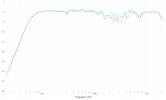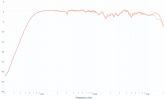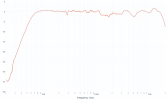A ~10db swing, 10db! Not 1, not 2, not 3, not 4, not 5, not 6, not 7, not 8. . .10 mother effing db!
Respectfully, I don't buy it. Either way, if that is enough to create a 10 db swing, then speaker measurements are meaningless which is even harder to believe.
A few things you can easily check yourself. Exemplary for the Wharedale 12.1 which is the subject of this thread.
Compare the vertical FR +-10° over 15kHz. In this frequency range, the edge diffraction hardly plays a role anymore, because of the narrow radiation of the tweeter.
If the center of the tweeter is taken as reference axis, the ver +10° and -10° FR of Amir's and Erin's NFS measurements should be nearly congruent.


In the vertical direction, both NFS measurement series show that the center of the tweeter was very well targeted.
Amir's measurements only contain more reflections due to the NFS device setup in the range 1000-10000Hz (sound reflecting surfaces that were not damped with damping material or something like this).
Since the loudspeaker is horizontally symmetrical, we can, for example, compare the +-20° measurements to see if the reference axis was optimally aligned here.


For Erin's +-20° measurements, the congruence of the measurements is perfect; for Amir, there are significant discrepancies above 10kHz (3dB diff
@15Khz).
The deviations in Amir's measurements can have different causes, on the one hand the horizontal reference axis could not have been aligned exactly with the tweeter or the measured loudspeaker itself was no longer perfectly symmetrical due to manufacturing tolerances or transport damage.
Now we compare how much the horizontal 40° FR measurements of Erin and Amir differ from each other - differences by the measurement mics are eliminated because of normalization.
To do this, we superimpose the measurements of the two normalized to the on-axis FR, because we likely know that Amirs speaker is slightly asymmetrical, we use his +-40° measurement - cyan Amir -40° (light green +40°), dark green Erin +40°:
Up to 14kHz the match of Erin's +40° and Amir's -40° is perfect.
Only above 17kHz the deviation becomes larger than 2dB.
The reasons for the deviation above 17kHz can be different and a mixture of different things.
It can be differences in the settings of the NFS measurements (some kind of none FR linear behavior) and very likely deviations due to manufacturer tolerances (different reflections by the tweeter WG).





